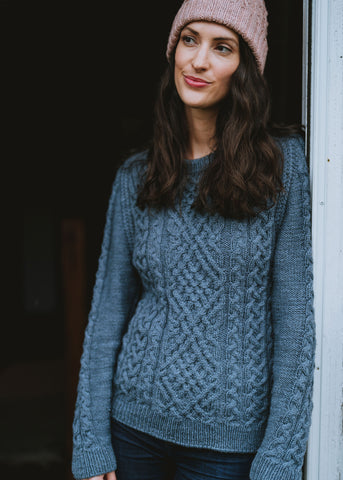Sweater Season: Schematics

Okay, we admit it: we're both die-hard sweater knitters, and we think pretty much any time of the year is sweater season. But, both of us have a penchant for starting new projects in this after-holiday time, as a moment to reflect and start to focus on something a little longer-term after our frenzied needles knit gifts for friends and relatives. It's still deep enough in the winter that there's plenty of time to wear the FO, and we're able to imbue it with hopes, dreams, and plans for the year ahead. As we've been working on sweaters for our upcoming Deep Winter collection, we've been thinking about some of our favorite sweater knitting tips and tricks from now, well, a lot of years and a lot of sweaters. We'll be sharing them with you over the next few weeks, in the hopes that some of them may help your first sweater projects of 2021, whether they're your first sweaters or your hundredth. See the full series here. Looking for an H+W sweater to start your year off right? Find the full set here.
What's a Schematic, and What Does it Tell You?
So, you've opened your brand-new sweater pattern, and somewhere in there, you've seen a diagram with a dizzying array of letters and/or numbers on it. Maybe it looks like a complete garment, or maybe it looks like a series of flat pieces, like something out of a sewing pattern. What is it? It's a schematic, a diagram showing the key finished measurements for each size provided for in the pattern.
But where do those numbers come from? If you'll spare me a brief indulgence for some arithmetic, the size of a finished piece of knitting is governed by two fundamental equations. Its width will be the stitch count divided by the number of stitches per inch, and its length will be the row count divided by the number of rows per inch.
A schematic, then, is based on a key assumption, a contract between you and the designer: the schematic shows you the finished measurements that the instructions in the pattern will produce, if any only if you knit the pattern exactly as written and got exactly the gauge stated in the pattern. If you make modifications, or if your gauge doesn't match, you won't get exactly the dimensions provided for in the schematic. In either case, you'll need to do a little bit of back-of-the-envelope math, but those fundamental equations will help you build a revised schematic for your project, taking into account your gauge and/or mods (and don't worry: we'll talk about how to make those adjustments next week).
We use schematics at two main moments in our knitting: when picking a size (and comparing it to a sample garment that fits about how we want our sweater to fit), and when blocking (where you'll typically see the phrase "block to schematic measurements" in your pattern).
We've got a whole bunch of our favorite sweater-knitting insights to share over the next few weeks, but we'd love to hear yours! Drop us a line at info@hudsonandwestco.com or in the comments below with your favorite sweater-knitting tip.










There are good-quality recovery agents out there who are legit and honest when it comes to recovery. I was a victim of Bitcoin investment fraud which I regretted not happening to anyone. What matters is the strangeness in you because being broken is not for weakness. I fell victim to a Bitcoin scam that saw me lose all my assets within a space of five days, I was catfished by a person who pretended to be a Bitcoin trader and investor, after depositing close to a million into this fake Bitcoin exchange, it was impossible to withdraw my assets and all communication with this so-called trader was compromised. I felt like I was going to die, until a friend of mine introduced THE HACK ANGELS RECOVERY EXPERT, a recovery agent that helped me recover all my stolen funds. I thought it was impossible, they recovered everything in less than 48 hours. I was in awe of how quick and easy it was, I can personally assure you all that THE HACK ANGELS RECOVERY EXPERT is a team of relentless, reliable, and trustworthy Bitcoin and data recovery experts. You can reach out them with this information if you have any reason to
Email: support@thehackangels.com
Website: www thehackangels.com
WhatsApp +1(520)200-2320
If you’re in London, you can even visit them in person at their office located at 45-46 Red Lion Street, London WC1R 4PF, UK. They’re super helpful and really know their stuff! Don’t hesitate to reach out if you need help.
USA UK CANADA
SSN NIN SIN
DL Photos front back with Selfie
Ping Us Here:
Telegram – @ leadsupplier – @ killhacks
What’sapp – +1 727’788’612’9
TG Channel – t.me/ leadsproviderworldwide
Email – hacksp007 at gmail dot com
VK MSNGR – @ leadsupplier
USA FULLZ UK FULLZ CA FULLZ
Name ssn dob dl address employee & Bank Info USA
Name nin dob dl address bank sort code account number
Name sin dob address mmn phone
DL photos Front & Back (USA-UK-CA-RU-GR-AUS-IT-FR & many other countries)
USA Business EIN Company Fullz
High Credit Scores Pros
Dead Fullz
Doordash|Ubereats|SBA|PUA|UI|TAX RETURN|FASFA Fullz KYC
Young Age Fullz 2011-2023
Old Age Fullz
Email Leads (Crpto|Umployement|Health|B2B|B2C|Payday|Loan|Medical)
Car Database with Vehicle Registration
CC fullz with CVV & Billing Address
Dumps with Pins Track 101 & 202
Loan Methods & Cash Out Methods
W-2 Fomrs with DL
Ein Documents & EIN Look Up
Fresh Spammed Combos
Tools & Tutorials for Spamming (For Learning Purpose Only)
SMTP RDP SHELLS C-PANELS
SCAM PAGES & Scam Pages Scripting
Web Mailers & Brutes
Bulk Email & SMS Senders
I.p’s & Server Proxies
SMTP Linux Root
Many other Stuff available, on demand we will provide
Fresh Suff & Info. Invalid, wrong, bad & unmatched info will be replaced
Don’t ask free samples for CC’s, Dumps, ID’s & Tools
#FULLZ #TOOLS #CC #CVV #DUMPS #USAFULLZ #UKFULLZ #CAFULLZ
#SSNFULLZ #NINFULLZ #SINFULLZ #DLPHOTOS #IDUSAPHOTO #CANADADL
#UKDRIVING #UBEREATS #DOORDASH #KYCSTUFF #CRYPOTPAYMENTS
#BTC #USDT #ETH #USDC #HACKINGTOOLS #SPAMMING #SCAMPAGES
#EMAILSENDER #FREEFULLZ #FREESTUFF #EINLOOKUP
*Be aware from scammers using our cloned names
*Contact only on the given details
Salutations to those who utilize the internet I’m here today to share the good news about what SPEED ETHICAL RECOVERY did for me over the past two months. I met a friend on Facebook, and we had a great conversation and mutual trust. He introduced me to cryptocurrency investing, and I agreed because he told me it would benefit me. I invested $350,000, but after a few weeks, when I refused to make any more investments, he stopped responding to my messages and stopped communicating with me, and I realized it was a scam. and I thought the world had ended because that was my life service. I even sold my car to make the investment, but a friend introduced me to SPEED ETHICAL RECOVERY. I sent them an email explaining what had happened, and they recovered all of my lost money in less than a day. I’m thrilled to share this testimony today, so if you’re in a similar situation, get in touch with them and they will help you.
Website ; https://speedethical-recovery.lovable.app
mail ; speedethicalrecovery@hotmail.com
WhatsApp ; +44 7394 810353
Signal ; +44 7587627007
Salutations to those who utilize the internet I’m here today to share the good news about what SPEED ETHICAL RECOVERY did for me over the past two months. I met a friend on Facebook, and we had a great conversation and mutual trust. He introduced me to cryptocurrency investing, and I agreed because he told me it would benefit me. I invested $350,000, but after a few weeks, when I refused to make any more investments, he stopped responding to my messages and stopped communicating with me, and I realized it was a scam. and I thought the world had ended because that was my life service. I even sold my car to make the investment, but a friend introduced me to SPEED ETHICAL RECOVERY. I sent them an email explaining what had happened, and they recovered all of my lost money in less than a day. I’m thrilled to share this testimony today, so if you’re in a similar situation, get in touch with them and they will help you.
Website ; https://speedethical-recovery.lovable.app
mail ; speedethicalrecovery@hotmail.com
WhatsApp ; +44 7394 810353
Signal ; +44 7587627007
I had lost over $752,000 by someone I met online on a fake investment project. After the loss, I had a long research on how to recover the lost funds. I came across a lot of Testimonies about THE HACKANGEL RECOVERY TEAMS. I contacted them providing the necessary information and it took the experts about 48 hours to locate and help recover my stolen money. If anyone is looking for a Recovery firm to Recover your lost Crypto. You can contact THE HACKANGEL RECOVERY TEAMS . I hope this helps as many out there who are victims and have lost to these fake online investment scammers. You can contact them by using
Email at support@thehackangels.com
Website at www.thehackangels.com
WhatsApp +1(520)200-2320